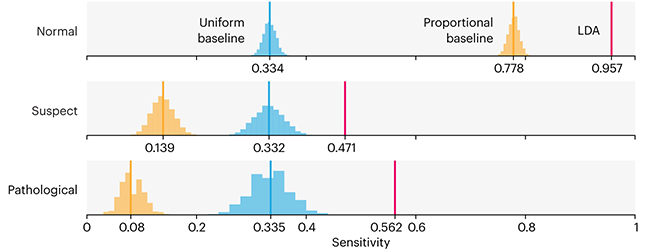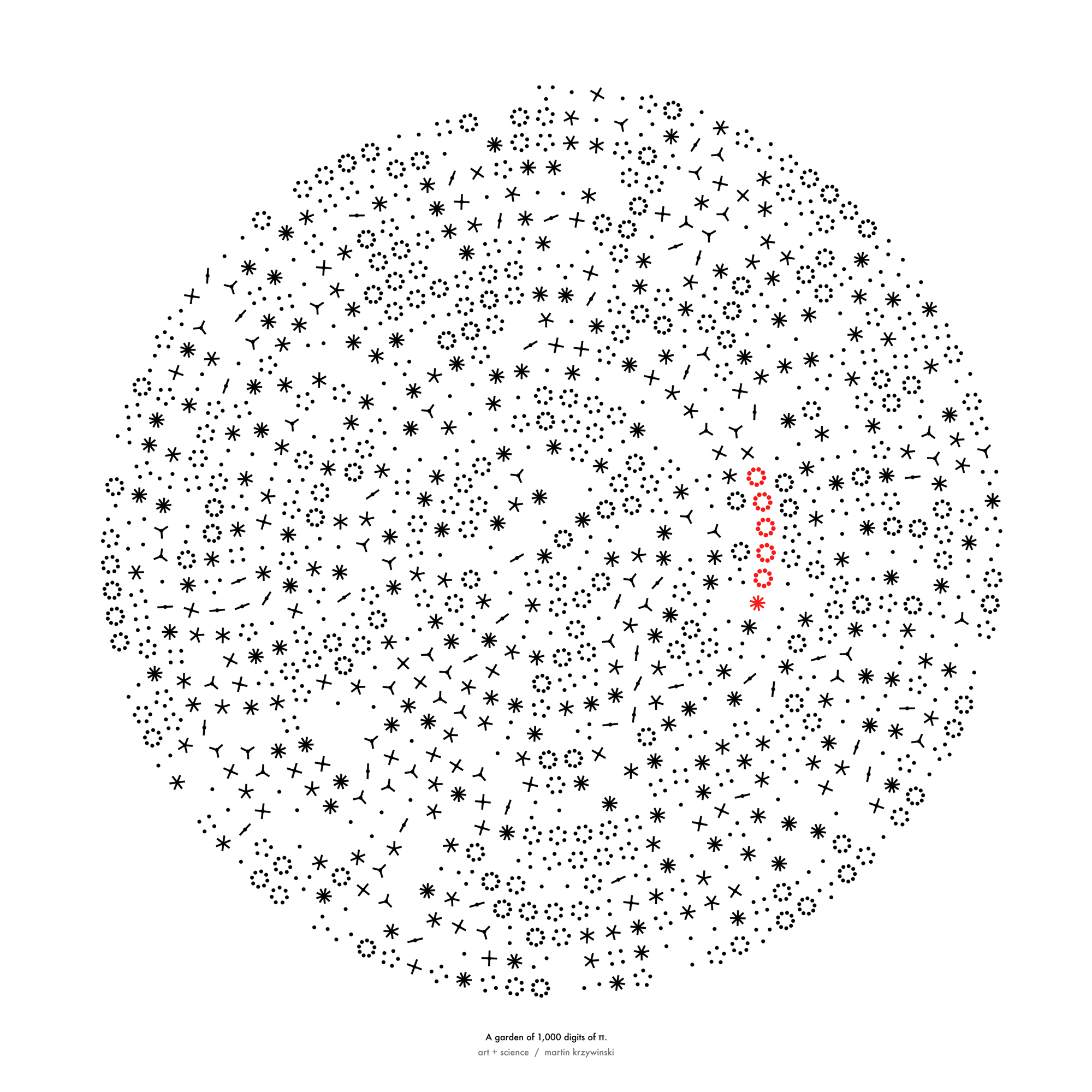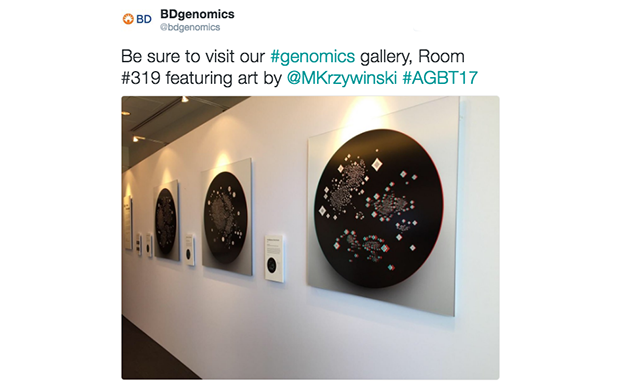BD Genomics stereoscopic art exhibit — AGBT 2017
Art is science in love.
— E.F. Weisslitz

contents

Science cannot move forward without storytelling. While we learn about the world and its patterns through science, it is through stories that we can organize and sort through the observations and conclusions that drive the generation of scientific hypotheses.
With Alberto Cairo, I've written about the importance of storytelling as a tool to explain and narrate in Storytelling (2013) Nat. Methods 10:687. There we suggest that instead of "explain, not merely show," you should seek to "narrate, not merely explain."
Our account received support (Should scientists tell stories. (2013) Nat. Methods 10:1037) but not from all (Against storytelling of scientific results. (2013) Nat. Methods 10:1045).
A good science story must present facts and conclusions within a hierarchy—a bag of unsorted observations isn't likely to engage your readers. But while a story must always inform, it should also delight (as much as possible), and inspire. It should make the complexity of the problem accessible—or, at least, approachable—without simplifications that preclude insight into how concepts connect (they always do).
Just like science, explaining science is a process—one that can be more vexing than the science itself!
In science one tries to tell people, in such a way as to be understood by everyone, something that no one ever knew before. But in poetry, it’s the exact opposite.
—Paul Dirac, Mathematical Circles Adieu by H. Eves [quoted]
I have previously written about the process of taking a scientific statement (Creating Scientific American Graphic Science graphics) and turning it into a data visualization or, more broadly, visual story.
The process of the creation of one of these visual stories is itself a story. A story about how the genome is not a blueprint, a discovery of Hilbertonians, which are creatures that live on the Hilbert curve, how algorithms for protein folding can be used to generate art based on the digits of `\pi`, or how we can make human genome art by humans with genomes. I've also written about my design process in creating the cover for Genome Research and the cover of PNAS. As always, not everything works out all the time—read about the EMBO Journal covers that never made it.

Here, I'd like to walk you through the process and sketches of creating a story based on the idea of differences in data and how the story can be used to understand the function of cells and disease.
The visual story is a creative collaboration with Becton Dickinson and The Linus Group and its creation began with the concept of differences. The art was on display at AGBT 2017 conference and accompanies BD's launch of the Resolve platform and "Difference of One in Genomics".
Starting with the idea of the "difference of one", our goal was to create artistic representations of data sets generated using the BD Resolve platform, which generates single-cell transcriptomes, that captured a variety of differences that are relevant in genomics research.
The data art pieces were installed in a gallery style, with data visualization and artistic expression in equal parts.
The art itself is an old school take on virtual reality. Unlike modern VR, which isolates the participants from one another, we chose a low-tech route that not only brings the audience closer to the data but also to each other.
The data were generated using the BD Resolve single-cell transcriptomics platform. For each of the three art pieces, we identified a data set that captured a variety of differences.
- disease onset—how does gene expression in tumor cells differ from normal cells?
- disease progression—as a tumor grows and spreads, how does expression change?
- background variation—how does gene expression change between normal cells that perform a different function?

The real surprise and insight is in difference that ultimately advance our thinking (Data visualization: amgibuity as a fellow traveller. (2013) Nat. Methods 10:613-615).
Figuring out which differences are of this kind requires that instead of "What's new?" we ask "What's different?"
Nasa to send our human genome discs to the Moon
We'd like to say a ‘cosmic hello’: mathematics, culture, palaeontology, art and science, and ... human genomes.



Comparing classifier performance with baselines
All animals are equal, but some animals are more equal than others. —George Orwell
This month, we will illustrate the importance of establishing a baseline performance level.
Baselines are typically generated independently for each dataset using very simple models. Their role is to set the minimum level of acceptable performance and help with comparing relative improvements in performance of other models.

Unfortunately, baselines are often overlooked and, in the presence of a class imbalance5, must be established with care.
Megahed, F.M, Chen, Y-J., Jones-Farmer, A., Rigdon, S.E., Krzywinski, M. & Altman, N. (2024) Points of significance: Comparing classifier performance with baselines. Nat. Methods 20.
Happy 2024 π Day—
sunflowers ho!
Celebrate π Day (March 14th) and dig into the digit garden. Let's grow something.

How Analyzing Cosmic Nothing Might Explain Everything
Huge empty areas of the universe called voids could help solve the greatest mysteries in the cosmos.
My graphic accompanying How Analyzing Cosmic Nothing Might Explain Everything in the January 2024 issue of Scientific American depicts the entire Universe in a two-page spread — full of nothing.
The graphic uses the latest data from SDSS 12 and is an update to my Superclusters and Voids poster.
Michael Lemonick (editor) explains on the graphic:
“Regions of relatively empty space called cosmic voids are everywhere in the universe, and scientists believe studying their size, shape and spread across the cosmos could help them understand dark matter, dark energy and other big mysteries.
To use voids in this way, astronomers must map these regions in detail—a project that is just beginning.
Shown here are voids discovered by the Sloan Digital Sky Survey (SDSS), along with a selection of 16 previously named voids. Scientists expect voids to be evenly distributed throughout space—the lack of voids in some regions on the globe simply reflects SDSS’s sky coverage.”
voids
Sofia Contarini, Alice Pisani, Nico Hamaus, Federico Marulli Lauro Moscardini & Marco Baldi (2023) Cosmological Constraints from the BOSS DR12 Void Size Function Astrophysical Journal 953:46.
Nico Hamaus, Alice Pisani, Jin-Ah Choi, Guilhem Lavaux, Benjamin D. Wandelt & Jochen Weller (2020) Journal of Cosmology and Astroparticle Physics 2020:023.
Sloan Digital Sky Survey Data Release 12
Alan MacRobert (Sky & Telescope), Paulina Rowicka/Martin Krzywinski (revisions & Microscopium)
Hoffleit & Warren Jr. (1991) The Bright Star Catalog, 5th Revised Edition (Preliminary Version).
H0 = 67.4 km/(Mpc·s), Ωm = 0.315, Ωv = 0.685. Planck collaboration Planck 2018 results. VI. Cosmological parameters (2018).
constellation figures
stars
cosmology
Error in predictor variables
It is the mark of an educated mind to rest satisfied with the degree of precision that the nature of the subject admits and not to seek exactness where only an approximation is possible. —Aristotle
In regression, the predictors are (typically) assumed to have known values that are measured without error.
Practically, however, predictors are often measured with error. This has a profound (but predictable) effect on the estimates of relationships among variables – the so-called “error in variables” problem.

Error in measuring the predictors is often ignored. In this column, we discuss when ignoring this error is harmless and when it can lead to large bias that can leads us to miss important effects.
Altman, N. & Krzywinski, M. (2024) Points of significance: Error in predictor variables. Nat. Methods 20.
Background reading
Altman, N. & Krzywinski, M. (2015) Points of significance: Simple linear regression. Nat. Methods 12:999–1000.
Lever, J., Krzywinski, M. & Altman, N. (2016) Points of significance: Logistic regression. Nat. Methods 13:541–542 (2016).
Das, K., Krzywinski, M. & Altman, N. (2019) Points of significance: Quantile regression. Nat. Methods 16:451–452.
Convolutional neural networks
Nature uses only the longest threads to weave her patterns, so that each small piece of her fabric reveals the organization of the entire tapestry. – Richard Feynman
Following up on our Neural network primer column, this month we explore a different kind of network architecture: a convolutional network.
The convolutional network replaces the hidden layer of a fully connected network (FCN) with one or more filters (a kind of neuron that looks at the input within a narrow window).

Even through convolutional networks have far fewer neurons that an FCN, they can perform substantially better for certain kinds of problems, such as sequence motif detection.
Derry, A., Krzywinski, M & Altman, N. (2023) Points of significance: Convolutional neural networks. Nature Methods 20:1269–1270.
Background reading
Derry, A., Krzywinski, M. & Altman, N. (2023) Points of significance: Neural network primer. Nature Methods 20:165–167.
Lever, J., Krzywinski, M. & Altman, N. (2016) Points of significance: Logistic regression. Nature Methods 13:541–542.











